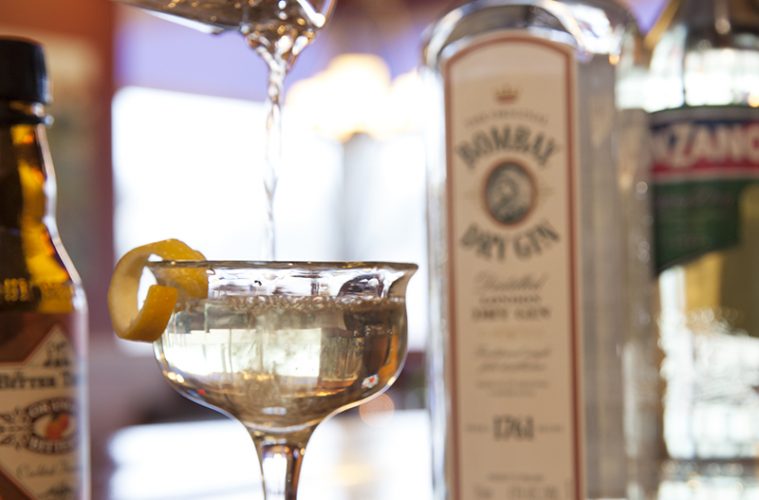Oh the poor, misunderstood martini. At some point in history, the classic combination of gin, vermouth, orange bitters, and a lemon twist was transformed into a rainbow-hued, sugary concoction, and “tini” became a suffix for any cocktail served in a martini glass. Thankfully, the era of appletinis is over and we can get back to the basics.
A martini by any other name isn’t a martini. An explanation: The martini was (and still is) categorized as a type of cocktail. Though its exact origin is unknown, recipes began appearing in bartending guides in the late-19th century. Some attribute the name to an Italian vermouth called Martini, which appeared on the market in 1863. By the time Prohibition hit, the martini was known to be what it is today: a mixture of gin, vermouth, and bitters—stirred, not shaken. Yes, James Bond got it wrong.
Why is shaking bad for a martini? It waters it down. Scientifically speaking, the more you shake a cocktail the more air bubbles are introduced, breaking down the ingredients and incorporating tiny shards of ice. For a simply structured drink like the martini, stirring allows for a softer chill, resulting in a clear (versus cloudy) cocktail. The general rule of thumb is to shake all cocktails containing citrus or egg and stir everything else. Shake your daiquiri, stir your old fashioned.
Now let’s talk about how vodka muscled gin out of the martini glass. Gin, like vodka, is a neutral spirit. With gin, juniper and other botanicals are added to give it its distinct aroma and flavor. Vodka, on the other hand, became popular in the 1950s thanks to a marketing campaign that touted its odorless, colorless attributes. During this time, vodka replaced gin in the traditional martini recipe and was renamed the Kangaroo. The name never stuck, and vodka martinis became ubiquitous alongside with Americans’ thirst for vodka.
But gin and vermouth are like peanut butter and jelly; the combination is complementary. Like gin, vermouth is made using a variety of botanicals, but with wine as its base. Vermouth can be sweet or dry, enjoyed as an apéritif over ice on its own, or as an ingredient in a variety of cocktails. Think of vermouth like olive oil: the better the quality, the better the taste. Just a touch added to cocktails offers bright complexity. The one thing vermouth doesn’t have is longevity—it should always be refrigerated and even then, lasts only about a month. Vermouth often gets mistreated, and is, therefore, under appreciated. Give a good, fresh bottle a chance.
There are a few different ways to order a classic martini: wet, dry, or 50:50. This terminology refers to the ratio of gin (or vodka, if specified) to vermouth. The less vermouth used, the drier the drink. Today, most bartenders consider dry to be a 6:1, while wet is 3:1, and 50:50 is exactly that. Order a bone-dry martini and the bartender will just rinse the glass with vermouth. A good bartender should ask you how you like your martini, and if she doesn’t, tell her.
Food and drink researcher Dave Arnold, author of Liquid Intelligence, says: “Half the fun of a martini is arguing over how it should be made.” And while there are endless variations, most tinker with the ratio of gin to vermouth. The recipe below is not too far off from the Prohibition era version, and accounts for a modest-sized cocktail coupe or martini glass (bigger isn’t better!) to ensure a cold sip every time. It’s a damn delicious martini.
Martini
2 ½ ounces London dry gin (Plymouth or Beefeater)
¾ ounce Dolin dry vermouth
1 dash of orange bitters
Lemon twist
Stir gin, vermouth, and bitters in a mixing glass filled with ice for one minute to thoroughly chill. Strain into a chilled martini glass. Garnish with lemon twist.
SIDEBAR
Martini Variations:
- Replace gin with vodka and you have a vodka martini, also known as a Kangaroo.
- Have the best of both worlds with a Vesper, made with vodka, gin, and Lillet, a French apéritif that takes the place of vermouth in this martini made famous by James Bond.
- A martini that is preferred shaken, not stirred, is actually called a Bradford.
- Instead of orange bitters, add a teaspoon (or more) of olive juice and garnish with an olive instead of a lemon for a dirty martini.
- Switch out the lemon twist for a pickled onion and get a Gibson.
- Channel your inner Julia Child with her favorite upside-down martini, heavy on the vermouth, light on the gin—about a 2:1 ratio.
- No vermouth? Follow the lead of Sir Winston Churchill who wittily remarked: “I would like to observe the vermouth from across the room while I drink my martini.” Technically, he was drinking straight, chilled gin with a lemon twist, otherwise known as a Churchill martini.

